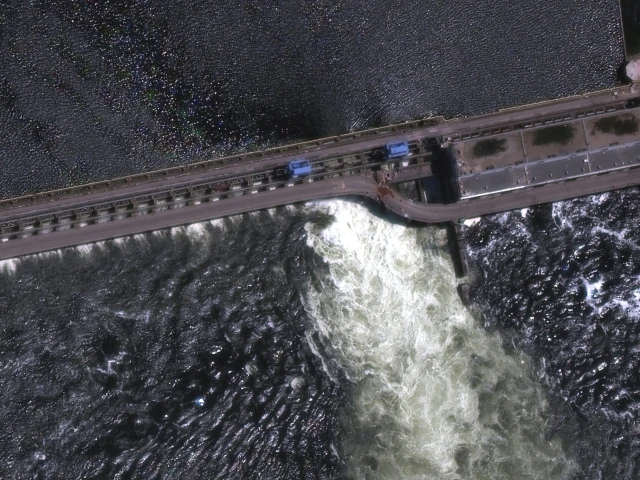About 42,000 people are at risk from flooding in Russian- and Ukrainian-controlled areas along the Dnipro River after a dam collapsed, as the UN aid chief warned of “grave and far-reaching consequences”.
Ukraine and Russia blame each other for the collapse of the massive dam on Tuesday, which sent floodwaters across a swathe of Ukraine’s war zone and forced thousands to flee.
Ukraine said Russia committed a deliberate war crime in blowing up the Soviet-era Nova Kakhovka dam, which powered a hydroelectric station. The Kremlin blamed Ukraine, saying it was trying to distract from the launch of a major counteroffensive that Russia says is faltering.
UN aid chief Martin Griffiths told the Security Council that the dam breach “will have grave and far-reaching consequences for thousands of people in southern Ukraine on both sides of the front line through the loss of homes, food, safe water and livelihoods”.
“The sheer magnitude of the catastrophe will only become fully realised in the coming days,” he said.
No deaths were initially reported, but US spokesperson John Kirby said the flooding had probably caused “many deaths”.
Ukrainian officials estimated about 42,000 people were at risk from the flooding, which is expected to peak on Wednesday.
In Kherson city, about 60 km (37 miles) downstream from the dam, water levels rose by 3.5 metres (11-1/2 feet) on Tuesday, forcing residents to slog through water up to their knees to evacuate, carrying plastic bags full of possessions and small pets in carriers.
“Everything is submerged in water, all the furniture, the fridge, food, all flowers, everything is floating. I do not know what to do,” Oksana, 53, said when asked about her house.
Buses, trains and private vehicles were marshalled to carry people to safety in about 80 communities threatened by flooding.
In Kherson, cracks of incoming artillery sent people trying to flee running for cover. In the evening, Reuters reporters heard four incoming artillery blasts near a residential neighbourhood where civilians were evacuating.
Residents in flooded Nova Kakhovka on the Russian-controlled bank of the Dnipro told Reuters that some had decided to stay despite being ordered out.
“They say they are ready to shoot without warning,” said one man, Hlib, describing encounters with Russian troops.
The Kazkova Dibrova zoo on the Russian-held riverbank was completely flooded and all 300 animals were dead, a representative said via the zoo’s Facebook account.
“More and more water is coming every hour. It’s very dirty,” Yevheniya, a woman in Nova Kakhovka, said by telephone.
The United States said it was uncertain who was responsible, but the deputy U.S. ambassador to the U.N., Robert Wood, told reporters it would not make sense for Ukraine to destroy the dam and harm its own people.
The Geneva Conventions ban targeting dams in war because of the danger to civilians.
Ukrainian President Volodymyr Zelenskiy said in a video address that his prosecutors had approached the International Criminal Court about the dam. Earlier, he said on Telegram that Russian forces blew up the power plant from inside.
“Residents are sitting on the roofs of their homes waiting to be rescued … This is a Russian crime against people, nature and life itself,” Oleksiy Kuleba, a senior official on Zelenskiy’s staff, said on Telegram.
The dam supplies water to a wide area of southern Ukrainian farmland, including the Russian-occupied Crimean peninsula, as well as cooling the Russian-held Zaporizhzhia nuclear plant.
Satellite images taken on Tuesday afternoon by Maxar Technologies showed houses and other buildings submerged, many with only their roofs showing.
Maxar said the images of more than 2,500 square km (965 square miles) between Nova Kakhovka and the Dniprovska Gulf, southwest of Kherson city on the Black Sea, showed numerous towns and villages flooded.
The U.N. nuclear watchdog said the Zaporizhzhia plant, upriver on the reservoir, should have enough water to cool its reactors for “some months” from a separate pond.
As Kyiv prepares for its long-awaited counteroffensive, some military analysts said the flooding could benefit Russia by slowing or limiting any Ukrainian advance along that part of the front line.
In a boost for Ukraine’s military, Zelenskiy said he had received “a serious, powerful” offer from countries ready to provide F-16 fighter jets.
“Our partners know how many aircraft we need,” Zelenskiy was quoted as saying in a statement on his website. “I have already received an understanding of the number from some of our European partners … It is a serious, powerful offer.”
Kyiv now awaited a final agreement with its allies, including “a joint agreement with the United States,” Zelenskiy said.
It is not clear which of Ukraine’s allies are ready to provide it with the jets.






Discussion about this post